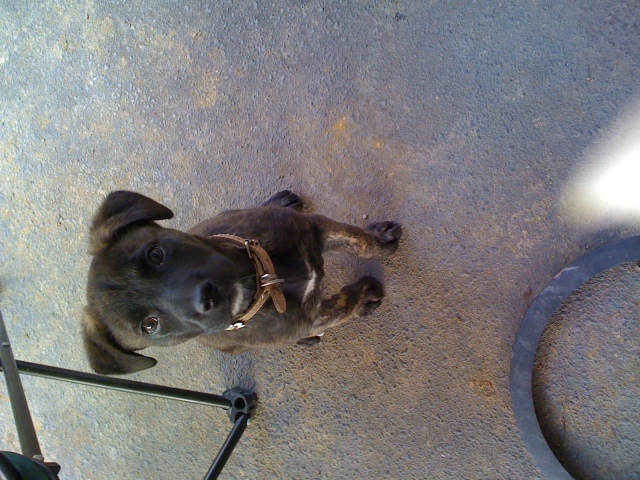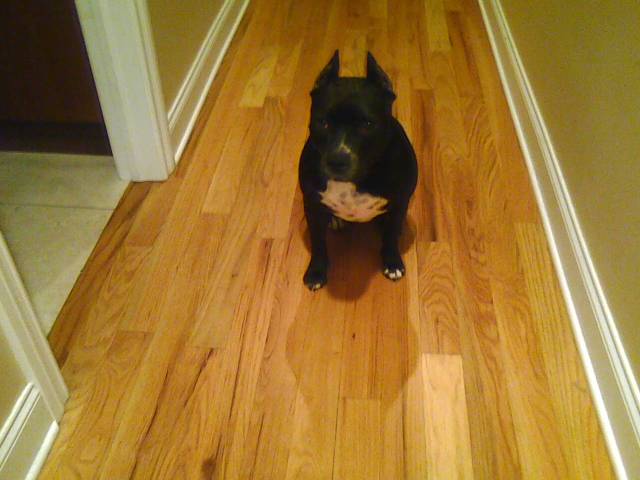QuestionI have a rescue lab who is fearful of EVERYONE. During fireworks we put her on acepromazine and noticed that I could walk her around the block and her entire behavior was normal. She would look at me when scared and take treats.
Can you sugguest how I could use this to help her adapt to being around people without running and peeing and craweling under anything handy (ever seen a lab try to squeeze under a couch?
Basically an looking for a protocol to talk to my vet about. Where I live there are no behavioral specialists so I have to pretty much figure this out and do.
Thanks
Julie
AnswerHi Julie,
Thank you for writing to me about your fearful Lab.
A dog who is genetically predisposed to general fearfulness, or a dog who was improperly socialized during a critical stage in his development, will probably not respond as well to treatment as a dog who has developed a specific fear in response to a specific experience.
The very first step is to get a full medical evaluation, including a thorough thyroid panel. Physical health plays a major role in dog temperament.
Unable to explain that something hurts, a dog will try to avoid that painful situation. Some dogs do this by moving away if they are free to do so, but these dogs as well as the more assertive types may react aggressively to ward off something they know from experience is going to hurt. With any fearful or aggressive dog behavior, medical issues are the first thing to consider.
Most fears won't go away by themselves, and, if left untreated, may get worse. Some fears, when treated, will decrease in intensity or frequency but may not disappear entirely. After you've ruled out medical causes, your first step in dealing with your dog's fearful behavior is to identify what triggers each fear. Is it startling noises? Is it fear of being left alone? Most fears can be treated using desensitization and counter-conditioning techniques, which require a lot of time and patience.
Desensitization Techniques:
Begin by exposing your dog to a very low level or small amount of whatever it is that's causing the fear. For example, if your dog is afraid of bicycles, start with a bicycle placed at a distance of 100 feet from your dog.
Reward for calm, non-fearful behavior in the presence of the bicycle. Gradually move the bicycle closer. As long as your dog remains relaxed, reward with treats and praise. If at any point your dog becomes anxious, move the bicycle further away and proceed at a slower pace.
When your dog can remain relaxed in the presence of a stationary bicycle, move the bicycle 100 feet away again, but have someone ride it slowly by. Again, gradually increase the proximity of the slowly moving bicycle, rewarding your dog for remaining calm and relaxed.
Repeat this procedure as many times as necessary, gradually increasing the speed of the moving bicycle.
This process may take several days, weeks, or even months. You must proceed at a slow enough pace that your dog never becomes fearful during the desensitization process. If you move too quickly you won't be successful.
When your dog has successfully overcome one fear, it may prove to be helpful for overcoming another. Having your dog on a low dose of the medication that has proven helpful in the past may hasten the success of the training. I recently worked with a Beagle that had severe separation anxiety. The dog was placed on anxiety medication and then desensitized. After a few days I was able to dramatically decrease the medication as the mind experienced calmness in the face of positive experience.
How to Use the Counter Conditioning Technique:
Counter conditioning works best when used in conjunction with desensitization and involves pairing the fear stimulus (for example, a moving bicycle) with an activity or behavior incompatible with the fear behavior (for example, the dog remaining in the "sit" position).
Using the desensitization technique example described previously, while your dog is exposed to the bicycle, ask your pooch to perform some obedience exercises, such as "sit" and "down." Reward for obeying and continue to have your dog obey commands as the bicycle is moved closer.
If your dog doesn't know any commands, teach a few using treats and praise. Don't ever use punishment, collar corrections, or scolding to teach commands, as the point of counter conditioning is to associate pleasant things with the stimulus that now causes fear.
Realistic Expectations:
Some of the things that frighten dogs can be difficult to reproduce and/or control. For example, if your dog is afraid of thunderstorms, he may be responding to other things that occur during the storm, such as smells, barometric pressure changes and/or changes in natural light. During the desensitization process, it is impossible for you to reproduce all of these factors. Another example would be if your dog is afraid of men. You may work at desensitizing, but if a man lives in your household and your dog is constantly exposed to him, this can disrupt the gradual process of desensitization.
You need to be patient with your dog and work hard not to become frustrated during the desensitization process.
When to Get HelpBecause desensitization and counter conditioning can be difficult techniques to master, and because behavior problems may increase if these techniques are done incorrectly, you may want to get professional, in-home help from an animal-behavior specialist. There are professional associations that can find someone within travelling distance of your residence.
It's important to keep in mind that a fearful dog who feels trapped or is pushed too far may become aggressive. Some dogs will respond aggressively to whatever it is that frightens them. If your dog displays any aggressive behavior, such as growling, snarling, snapping, or baring teeth, stop all behavior modification procedures and seek professional help from an animal-behavior specialist as soon as possible.
Medication may be an option that has to become part of your dog's daily life because it can help reduce your dog's anxiety levels. Your veterinarian is the only person who is qualified and licensed to prescribe medication for your dog. Don't attempt to give your dog any over-the-counter or prescription medication without consulting with your veterinarian. Animals don't respond to drugs the same way people do, and a medication that may be safe for humans could be fatal to your dog.
Drug therapy alone won't reduce fears and phobias permanently, but in extreme cases, behavior modification and medication used together may be the best approach.
What Not to Do
Do not punish your dog for being afraid. Punishment will only create more fear.
Do not try to force your dog to experience the object or situation that is causing fear. For example, if your dog is afraid of bicycles and you force pooch to stand in place while bicycles whiz by, the fear of bicycles will probably increase.
Never punish your dog after the fact for destruction or house soiling caused by anxiety or fear. Animals don't understand punishment after the fact, even if it's only seconds later. This kind of destruction or house soiling is the result of panic, not misbehavior. Punishment will do more harm than good.
Some other suggestions:
-Feed your dog a whole food natural diet or a human grade dog food such as Biljac, Paul Newman, Variety, Old Mother Hubbard, Wellness, Solid Gold, Spots Stew, etc. A raw food diet (BARF) might offer some help as well. You can add yogurt for the calcium which is calming and chicken or turkey provides tryptophan which is also calming.
-If you work with a holistic vet the addition of melatonin and tryptophan into the diet can offer a calming effect.
-Training is a good way to offer confidence and grounding to your dog's mind and body. Repeat basic commands throughout the day to stimulate the brain to center itself and give your dog a sense of accomplishment.
-Agility classes offer a great deal of confidence to a dog and have been known to help in the resolution of many psychological issues along with desensitation.
-Exercise is a biggie! Exercise stimulates endorphins and can be as effective as drugs such as prozac. A tired dog is a calm dog so I suggest vigorous exercise such as 45 minutes brisk walks, perhaps two a day. Make sure that the weather isn't too hot and that your dog has plenty of water.
-I would also suggest purchasing an Anxiety Wrap at sitstay.com/ This wrap was originally developed for fear of thunderstorms but can be a helpful tool for all kinds of anxiety.
The best of luck with your precious dog.
Regards,
Shelley Davis
www.bednbiscuit.com

 dog size
Question
raven
I have a 5 month old Pomeranian/C
dog size
Question
raven
I have a 5 month old Pomeranian/C
 Puppy Teething, Jumping, Bathing and Ear drops
Question
Puppy Trinnie
Hi, I have a 5 & 1/2 month old S
Puppy Teething, Jumping, Bathing and Ear drops
Question
Puppy Trinnie
Hi, I have a 5 & 1/2 month old S
 Diarrhea in Nursing Bitches
QuestionAtrix & Pup
QUESTION: My Champion Mi
Diarrhea in Nursing Bitches
QuestionAtrix & Pup
QUESTION: My Champion Mi
 worried about mom dog not lactating enough
Question
angel and her pups jus
I have a small mixed br
worried about mom dog not lactating enough
Question
angel and her pups jus
I have a small mixed br
 AmStaff Terrier
QuestionMy dog
QUESTION: I have a 2 1/2 year old
AmStaff Terrier
QuestionMy dog
QUESTION: I have a 2 1/2 year old